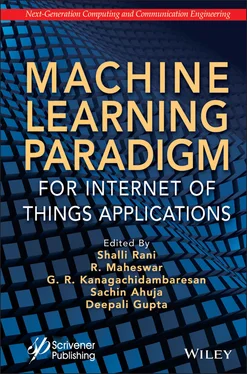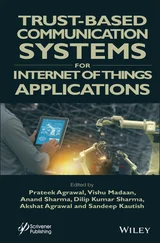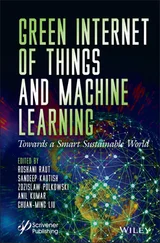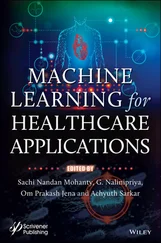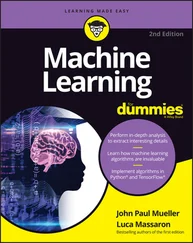14 Chapter 14Figure 14.1 (a) Pneumonia x-ray image, (b) Healthy x-ray image.Figure 14.2 Xception network architecture.Figure 14.3 (a) Model accuracy, (b) Model loss.Figure 14.4 Confusion matrix.
1 Chapter 2 Table 2.1 Feasibility study summary. Table 2.2 Harvest prediction: Raw data fields. Table 2.3 Paddy harvest prediction - Data set. Table 2.4 Demand predict: Raw data fields. Table 2.5 Rice demand prediction: Data set.Table 2.6 Mutation rate effect.Table 2.7 Mutation probability effect.
2 Chapter 3Table 3.1 Classification accuracy.
3 Chapter 5Table 5.1 Text-based CAPTCHA used in commercial website.Table 5.2 Breaking methodology and success rate of various sources.Table 5.3 Pixel value changed entry.Table 5.4 Look up table entry.
4 Chapter 7Table 7.1 Offline evaluation metrics.Table 7.2 Illustration of confusion matrix.Table 7.3 Overview of additional metrics.Table 7.4 Overview of filtering techniques.Table 7.5 Overview of classifier algorithm.Table 7.6 Overview of the explored dataset.Table 7.7 System generated metric results using MovieLens with Random and SVD wh...Table 7.8 System generated metric results using MovieLens with SVD and SVD++ whe...
5 Chapter 8Table 8.1 Raspberry Pi history with version and configuration.
6 Chapter 9Table 9.1 Phase 2: algorithm for key hub identification.Table 9.2 Phase 3: algorithm for vehicle routing.
7 Chapter 13Table 13.1 Comparison of various routing protocols for different quality paramet...
8 Chapter 14Table 14.1 Dataset description.Table 14.2 Model metric parameters.
1 Cover
2 Table of Contents
3 Title Page
4 Copyright
5 Preface
6 Begin Reading
7 Index
8 End User License Agreement
1 v
2 ii
3 iii
4 iv
5 xiii
6 xiv
7 1
8 2
9 3
10 4
11 5
12 6
13 7
14 8
15 9
16 10
17 11
18 12
19 13
20 14
21 15
22 16
23 17
24 18
25 19
26 20
27 21
28 22
29 23
30 24
31 25
32 26
33 27
34 28
35 29
36 30
37 31
38 32
39 33
40 34
41 35
42 36
43 37
44 38
45 39
46 40
47 41
48 42
49 43
50 44
51 45
52 46
53 47
54 48
55 49
56 50
57 51
58 53
59 54
60 55
61 56
62 57
63 58
64 59
65 60
66 61
67 62
68 63
69 64
70 65
71 66
72 67
73 68
74 69
75 70
76 71
77 72
78 73
79 74
80 75
81 76
82 77
83 78
84 79
85 80
86 81
87 82
88 83
89 84
90 85
91 86
92 87
93 88
94 89
95 90
96 91
97 92
98 93
99 94
100 95
101 97
102 98
103 99
104 100
105 101
106 102
107 103
108 104
109 105
110 106
111 107
112 108
113 109
114 110
115 111
116 113
117 114
118 115
119 116
120 117
121 118
122 119
123 120
124 121
125 122
126 123
127 124
128 125
129 126
130 127
131 128
132 129
133 130
134 131
135 132
136 133
137 134
138 135
139 136
140 137
141 138
142 139
143 140
144 141
145 142
146 143
147 144
148 145
149 146
150 147
151 148
152 149
153 150
154 151
155 152
156 153
157 154
158 155
159 156
160 157
161 158
162 159
163 160
164 161
165 162
166 163
167 164
168 165
169 167
170 168
171 169
172 170
173 171
174 172
175 173
176 174
177 175
178 176
179 177
180 178
181 179
182 181
183 182
184 183
185 184
186 185
187 186
188 187
189 188
190 189
191 190
192 191
193 192
194 193
195 194
196 195
197 196
198 197
199 198
200 199
201 200
202 201
203 202
204 203
205 204
206 205
207 206
208 207
209 209
210 210
211 211
212 212
213 213
214 214
215 215
216 216
217 217
218 218
219 219
220 220
221 221
222 222
223 223
224 224
225 225
226 226
227 227
228 229
229 230
230 231
231 232
232 233
233 234
234 235
235 236
236 237
237 238
238 239
239 240
240 241
241 242
242 243
243 244
244 245
245 247
246 248
247 249
248 250
249 251
250 252
251 253
252 254
253 255
254 256
255 257
256 258
257 259
258 260
259 261
260 262
261 263
262 265
263 266
264 267
265 268
266 269
267 270
268 271
269 272
270 273
271 274
272 275
273 276
274 277
275 278
276 279
277 280
Scrivener Publishing100 Cummings Center, Suite 541J Beverly, MA 01915-6106
Next-Generation Computing and Communication Engineering
Series Editors: Dr. G. R. Kanagachidambaresan and Dr. Kolla Bhanu Prakash
Developments in artificial intelligence are made more challenging because the involvement of multi-domain technology creates new problems for researchers. Therefore, in order to help meet the challenge, this book series concentrates on next generation computing and communication methodologies involving smart and ambient environment design. It is an publishing platform for monographs, handbooks, and edited volumes on Industry 4.0, agriculture, smart city development, new computing and communication paradigms. Although the series mainly focuses on design, it also addresses analytics and investigation of industry-related real-time problems.
Publishers at Scrivener
Martin Scrivener ( martin@scrivenerpublishing.com) Phillip Carmical ( pcarmical@scrivenerpublishing.com)
Machine Learning Paradigm for Internet of Things Applications
Edited by
Shalli Rani,
R. Maheswar
G. R. Kanagachidambaresan
Sachin Ahuja
and
Deepali Gupta

This edition first published 2022 by John Wiley & Sons, Inc., 111 River Street, Hoboken, NJ 07030, USA and Scrivener Publishing LLC, 100 Cummings Center, Suite 541J, Beverly, MA 01915, USA
© 2022 Scrivener Publishing LLC
For more information about Scrivener publications please visit www.scrivenerpublishing.com.
All rights reserved. No part of this publication may be reproduced, stored in a retrieval system, or transmitted, in any form or by any means, electronic, mechanical, photocopying, recording, or otherwise, except as permitted by law. Advice on how to obtain permission to reuse material from this title is available at http://www.wiley.com/go/permissions.
Wiley Global Headquarters
111 River Street, Hoboken, NJ 07030, USA
For details of our global editorial offices, customer services, and more information about Wiley products visit us at www.wiley.com.
Читать дальше
